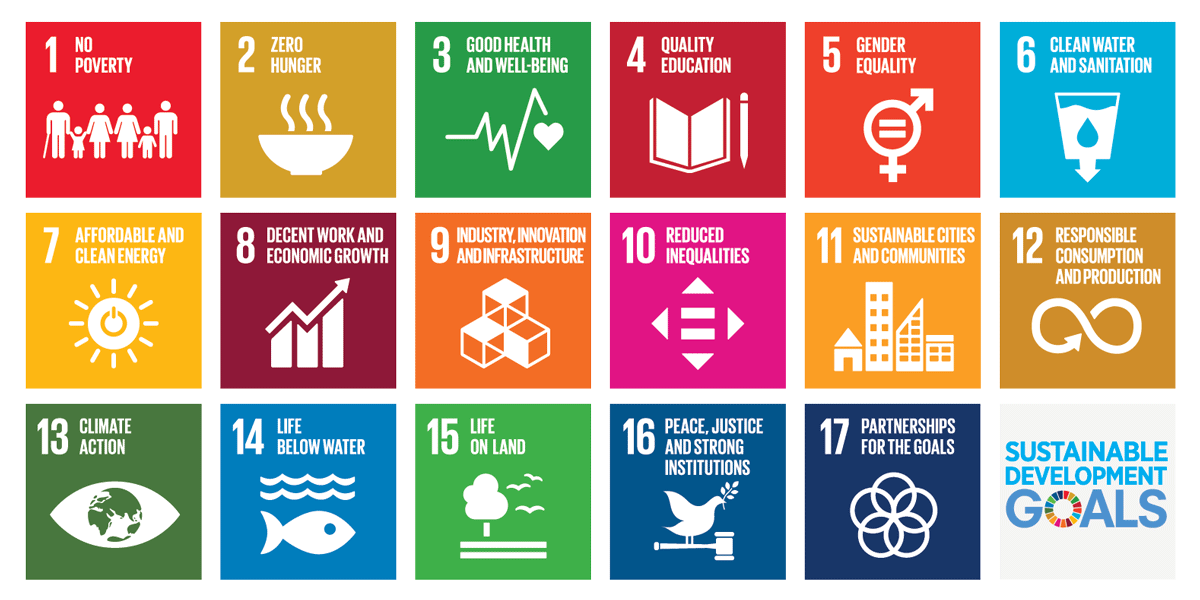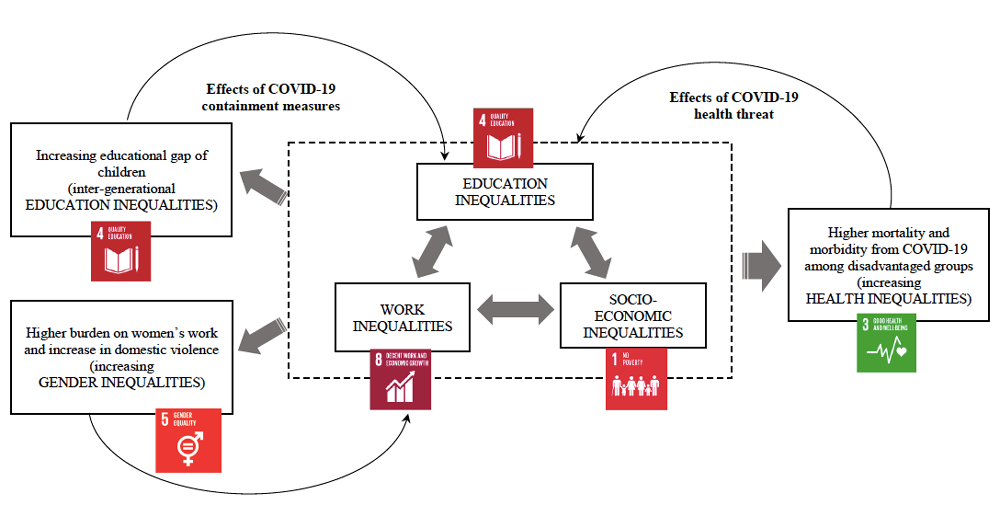Covid-19 Pandemic and Global Inequalities
Posted on Thursday 1 October 2020
Beyond its immediate impact on health-related inequalities, the pandemic is worsening other, inter-linked inequalities which is setting back the progress on sustainable development goals.

The challenge for society
Earlier in March, the American pop singer Madonna claimed that the Sars-CoV-2 was ‘the great equalizer’, which did not distinguish between the rich or poor. In stark contrast to her simplistic claim, it is now clear that our risks and vulnerabilities differ considerably depending on pre-existing, sedimented, socio-economic inequalities that afflict our societies. These stand brutally exposed—and not just by the virus we rush to contain, cure and hope to inoculate ourselves against. As protests against racial oppression continue, the superrich have added hundreds of billions to their personal wealth.
Far from home, though, the long-term repercussions of these crises we face—public health, economic, ecological, and political—are likely to set UN Sustainable Development Goals (SDGs), an agenda for global development, back significantly. In particular, we focus on SDG 10, which relates to reducing inequalities in our societies. The unpredictability of the virus and its dramatic domino effects as it spreads across our homes, workplaces, and public spaces will create, we believe, a range of disproportionate, non-linear adverse outcomes, particularly those already disadvantaged.
As is increasingly becoming clear, the pandemic is exacerbating health inequalities within and across nations. In this brief, we contend that: (a) the pandemic is widening other, inter-linked forms of socio-economic inequalities; and (b) the patterns of inequalities observed in OECD countries will present themselves in more exacerbated forms in LMICs (Low and Middle-Income Countries), because of a number of inter-linked factors; and (c) such inequalities are rapidly trickling down to future generations.
This effect will compromise and debilitate the capabilities of the poor to fight their way through the pernicious inequalities they encounter, setting back any global progress made by development agencies on SDGs, globally, by years.
Widening health-related inequalities
It has now become increasingly clear that the COVID-19 pandemic has widened health inequalities. In the United Kingdom, for example, mortality rates in the most deprived areas (lowest income decile) were more than double those in the least deprived areas (highest income decile). Higher mortality rates are a function of health vulnerabilities that predate the onset of the virus.
Studies have shown that those living in deprived areas are far more likely to be affected by pre-existing medical conditions; which in turn increases their risk to the virus and reduces their chances of full recovery. Given the long-standing racial disparities in our societies and communities, it is hardly a surprise that members of the BAME communities constitute a disproportionately high percentage of those most vulnerable to the virus.
The health risks faced by the vulnerable in our societies, the poor, those from lower caste, religious and ethnic minorities, those with long-term health conditions etc., are further compounded by a host of factors. Not only do the poor work on lower – often less than minimum – wages, they also have to work longer hours on precarious contracts with no job security, in the unregulated and informal sectors of the economy, and more often than not cannot (or in some cases are not allowed to) work from home. They find themselves living in small, poorly ventilated houses that make social distancing within families impossible. They also have poorer access to health facilities and medical insurance which further narrows the speed and breadth of diagnostic and curative services they can benefit from, both related and unrelated to COVID-19.
Exacerbating other inequalities
We argue that education, income, and gender-related inequalities are worsening as a result of the widening health inequalities, caused by the pandemic and governmental responses (or lack thereof).
The effect of frequent, extended, and uncertain school closures, for example, is already affecting children’s educational attainments. Households with lower incomes are at a particular disadvantage when it comes to providing home-schooling: as they are less likely to have adequate access to digital resources and less time to devote to children’s education because of the nature of their jobs. As a result, children from better-off households have worked on average 30% more than their lower-income counterpart during lockdown.
A second aspect of increasing inequalities relates to the economic recession caused by the pandemic and the subsequent business shut-down. Data from the UK highlights that 80% of lowest-paid workers are either employed in a sector that was shut-down or are unable to work from home, compared to only 25% of highest-paid workers. 80% of the hospitality and entertainment businesses, for example, had to shut down during lockdown. Some of the lowest paying workers in the UK economy are employed in such businesses. Moreover, as governments start winding down their furlough schemes, living allowances, and social security, disadvantaged households are facing economic downturns, layoffs, and salary cuts even as they continue to face the grim prospect of contagion, illness, and death. All at a time when our economies need the workers to kick-start our economies—on the farms and in the factories, on the shop floors and in the warehouses, not to mention all the other work and services that are essential to our lives.
The third important area of growing inequalities relates to gender disparities (SDG5). School closures and the new necessity for households to provide for childcare, home-schooling and housework has created a disproportionate burden on women, especially among working couples with limited access to childcare facilities. Mothers have a higher likelihood to experience COVID-induced career disruptions and bear most of the additional childcare. It has also led to a disturbing rise in cases of gender violence.
Accelerating inequalities in LMICs
The patterns currently being seen in OECD countries will soon be felt, we contend, far more acutely in LMICs. In response to the pandemic, schools in India were shut down in April, 2020 to reduce risks of infection and protect the country’s already burdened public health system. The shutdown has already impacted nearly 247 million children; of which only a quarter have access to the internet; thus, disrupting the education of tens of millions of children. It has also disrupted India’s much-needed mid-day meal scheme on which 120 million children across the country depend. All this is likely to create a long-lasting educational gap counteracting the slow progress on SDG4 (Quality Education), and further accentuates socio-economic disparities in future generations.
The economic situation is far more dire in the context of LMICs. In India, for example, an unplanned lockdown led to mass reverse-migration of workers from the cities to their villages. Left without jobs, wages, homes, or even food, an estimated 120-140 million workers walked, cycled, and travelled on buses and trains over hundreds of kilometres to return home – where perhaps less uncertain futures awaited them. According to ILO estimates, nearly 400 million workers in India’s informal economy face the dreadful prospect of slipping into even deeper poverty than before. This has direct repercussions on SDG8 (decent work and economic growth) and creates a multiplier effect of widening inequalities relating to SDG4 and SDG3.
The closure of schools have increased incidence of domestic violence, abuse, and malnutrition against girl children in India. In neighbouring Bangladesh, for example, the government has exploited the pandemic to hasten the sale of public-sector jute mills, many of which rely on female workers. Protests by workers demanding wage-hike, repealing privatization, and payment of pensions and gratuities have been met with growing police violence, attacks on trade unionists, and increasing poverty among the women workers. Rolling back on the – albeit limited – progress achieved on gender equality over the past decades, the pandemic is likely to create enormous economic and social costs, as women retreat from the labour market because of the impending economic recession, and/or to care for their children or an elderly parent.
Finally, the lockdown has also set back immunization programmes in LMICs. According to a recent study in the Lancet, supply-chain disruptions, lockdowns, and absence from work among health care workers have led to missed vaccinations among young children, which will inadvertently contribute to further contagion of Sars-CoV-2 virus. In countries such as Ghana, Vietnam, Zimbabwe, children have missed several vaccinations. Moreover, public trust in large-scale immunization is under threat in countries such as Liberia. All of which, together, set back progress on SDGs in several parts of the world.
Making sense of inequalities
Paradoxically, the COVID-19 pandemic has created a setting where inequalities – and their interdependencies – can be directly observed, made sense of, and carefully re-assessed both at macro – policy – level, and at micro – individual – level, within households. The interaction of the abovementioned effects creates an overall, systemic outcome of growing social exclusion and injustice.
Figure 1 summarizes the patterns of inequality interdependencies and highlights how a setback on one of the affected SDG triggers setbacks on other through feedback loops. The centre of the figure depicts the entrenched dependencies between inequalities in educational attainments, inequalities in work conditions and socio-economic disparities. Given the exogenous shock caused by the circulation of Sars-CoV-2, these inequalities have resulted in a disproportionate share of disadvantaged individuals being affected or dying from COVID-19, thereby increasing already existing health inequities (right side of the figure). On the left side, we see instead the effects of COVID-19 policy containment measures, such as lockdown and school closure. These have led to increase gender inequalities and further gaps in educational attainments of children, thereby creating inter-generational educational disparities.
The figure suggests that current and future policymaking should consider the effects of policy measures not only on isolated symptoms of inequalities but also – and most importantly – on how policies influence the complex patterns of interdependencies within socio-economic disparities, ultimately affecting progress for SDGs.
While the proposed framework generates specifically from the experience of COVID-19, it highlights patterns of widening inequalities that can surface during any societal crisis caused by sudden exogenous shocks. The COVID-19 pandemic has thus provided an opportunity to start developing a more systemic, dynamic view on inequalities that might inform future research and policymaking.

Figure 1 - Patterns of increasing inequalities and interdependencies among Sustainable Development Goals setbacks due to the COVID-19 pandemic (source: authors)
Notes to editors:
About the authors

Professor Federica Angeli
Research Title: Chair in Management
Federica’s research examines how organisations and inter-organisational networks adapt and learn to address complex societal issues, with a particular focus on inclusive healthcare delivery and poverty alleviation.

Dr Arun Kumar
Research Title: Lecturer in International Management
Arun researches the role of business and management in global development.
